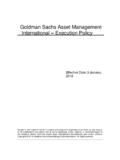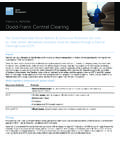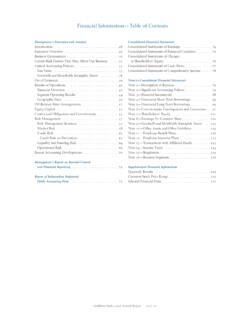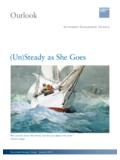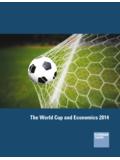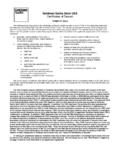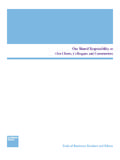Transcription of Building Better Global Economic BRICs - Goldman Sachs
1 Important disclosures appear at the end of this Better Global Economic BRICsJim O Neill30th November 2001 Global EconomicsPaper No: 66nIn 2001 and 2002, real GDP growth in large emerging market economies will exceed thatof the end-2000, GDP in US$ on a PPP basis in Brazil, Russia, India and China (BRIC) wasabout of world GDP. On a current GDP basis, BRIC share of world GDP is 8%.nUsing current GDP, China s GDP is bigger than that of the next 10 years, the weight of the BRICs and especially China in world GDP willgrow, raising important issues about the Global Economic impact of fiscal and monetarypolicy in the line with these prospects, world policymaking forums should be re-organised and inparticular, the G7 should be adjusted to incorporate BRIC from theGS Financial Workbenchat thanks to David Blake, Paulo Leme, BinitPatel, Stephen Potter.
2 David Walton and othersin the Economics Department for their Paper No November 2001 Goldman Sachs Economic Research GroupIn London+44(0)20 7774 1160 Jim O Neill, & Head of Global Economic ResearchGavyn Davies, & Chief International EconomistDavid Walton, & Chief European EconomistAndrew Bevan, & Director of International Bond Economic ResearchErik Nielsen, Director of New European Markets Economic ResearchStephen Potter, & Senior Global EconomistAl Breach, & International EconomistLinda Britten, & Global Economics Mgr, Support & SystemsBen Broadbent, & Senior European EconomistMichael Buchanan, & International EconomistFrancesco Garzarelli.
3 & International EconomistStephen Hull, & International EconomistSandra Lawson, & International EconomistBinit Patel, & International EconomistFabio Scacciavillani, & Senior European EconomistCarlos Teixeira, & International EconomistJavier P rez de Azpillaga, European EconomistThomas Stolper, Associate EconomistPhilippa Knight, European Economics Manager, Admin and SupportFiona Lake, Research AssistantInes Lopes, Research AssistantVictoria Malpass, Research AssistantJocelyn McCafferty, Research AssistantJens J Nordvig-Rasmussen, Research AssistantRoopa Purushothaman, Research AssistantAnnMarie Terry, Research AssistantIn New York+1(212)
4 902 6807 William Dudley, & Chief US EconomistPaulo Leme, & Director of Emerging Markets Economic ResearchAlberto Ades, & Director of Emerging Markets Bond & Currency ResearchJan Hatzius, & Senior EconomistEdward McKelvey, & Senior EconomistJohn Youngdahl, & Senior EconomistFederico Kaune, & Senior EconomistMarcel Kasumovich, & International EconomistRumi Masih, & International EconomistDaniel Tenengauzer, & International EconomistDemian Reidel, Associate Economist (FI Research)Jes s Viejo, Associate EconomistMelisse Dornier, US Economics Manager, Admin & SupportPablo Morra, Research AssistantHumberto Medina, Research AssistantRichard Crump, Research AssistantLesya Karpa, Research AssistantIn Paris+33(1) 4212 1343 Nicolas Sobczak, & Senior European EconomistIn Frankfurt+49(69) 7532 1200 Thomas Mayer, & Director of Euroland Economic ResearchEva Frede, Research AssistantDirk Schumacher, Research AssistantIn Toronto+1(416)
5 343 8793 Mark Chandler, & Senior EconomistJason Daw, Research AssistantIn Hong Kong+852 2978 1941 Sun Bae Kim, & Director of Asia Pacific Economic ResearchFred Hu, & Head of Greater China Economics & StrategyJohn Anderson, & Senior International EconomistDominic Wilson, & International EconomistDick Li, Associate EconomistRita Ng, Research AssistantIn Tokyo+81(3) 3589 8911 Tetsufumi Yamakawa, & Director of Japan Economic ResearchYuriko Tanaka, & Associate EconomistTakuji Okubo, Senior EconomistTomohiro Ohta, Associate EconomistAyako Sano, Research AssistantIn Singapore+65 228 8478 Adam Le Mesurier, & Senior International EconomistEnoch Fung, Research AssistantGoldman Sachs Research personnel may be contacted by electronic mail through the Internet at Paper No November 2001 SUMMARYB uilding Better Global Economic BRICsThis paper discusses the state of the world economy as we approach year-end.
6 With particular emphasis on therelationship between the G7 and some of the larger emerging market show that our latest forecasts for 2001 and 2002 suggest a healthier outlook in some of the larger emergingmarket economies compared to the G7. We are currently forecasting world GDP growth in 2002 withBrazil, Russia, India and China ( BRICs ) each set to grow again by more than the the divergent degree of the 2001/2002 relative outlook is unlikely to be sustained over the next decade, ahealthier environment for the BRICs seems likely to remain, and as a result, their share of world GDP is set a PPP basis, the aggregate size of the BRICs was about of world GDP at the end of 2000, somewhathigher than both Euroland and Japan.
7 Whilst on a current GDP basis, the size of the BRICs is just under 8%,this is also set to rise. Some of these countries are already bigger than some individual G7 economies; China, of world GDP (using current US$ prices), was slightly bigger than Italy at the end of 2000, and notablylarger than consider four different scenarios for the next decade based on various nominal GDP assumptions for 11countries (the G7 and BRICs ), and different assumptions about exchange-rate conversion. The nominal GDPassumptions reflect our best guess about the likely trend rate of real GDP growth and Scenario A, we simply convert future nominal GDP projections at end-2000 exchange Scenario B, we convert GDP projections using our GSDEER/GSDEEMER fair value exchange C again converts at end-2000 exchange rates, but assumes that the 2001/2002 nominal GDP pathscontinue for 10 D converts projected GDP trends using PPP conversions rather than estimated end-2011 current all four scenarios.
8 The relative weight of the BRICs rises from at present (in current US$) to , orfrom to , converting at PPP rates. In each of these scenarios, the increasing weight is led byChina, although the other three grow relative to the G7 countries also show our latest projections for likely timing of future EU joiners and subsequent membership ofEMU. We suggest that there is a 50% or greater probability of another 13 countries becoming active membersof EMU by the beginning of 2007, taking the total membership to 25 from today s argue that with 25 members of EMU, it will be necessary to reform the active membership of the ECBG overning Council and recommend instead the introduction of an FOMC-like rotating voting a development should be accompanied by a reduction in Euroland representation at the G7 from 3countries to 1.
9 And provide the basis for a significant reform of the view of the expected continued relative growth of the BRICs , the opportunity should be taken to incorporateChina and probably Brazil and Russia and possibly India, expanding the key body of Global Economic policyco-ordination to 8 or is time for the world to build Better Global Economic : THE SIZE OF THEWORLD ECONOMYT able 1 below shows the current size of GDP for the20 leading economies of the world, based on bothPurchasing Power Parity (PPP) and current prices atthe end of 2000. The table also shows the actual shareof world GDP on either estimate, and the differencebetween them, as well as the size of the populationand GDP per can be seen, there are some very differentestimates about therelativesize and share of theworld economy depending on which technique (PPPweights or current GDP weights), is used.
10 Perhapsnot surprisingly, the actual absolute size doesnotdiffer much for most of the G7 countries, with theexception of Japan. Given Japan s expensiveness ona PPP basis, the PPP weighting suggests an economyless than 75% of its current GDP relative picture shifts dramatically whenimportant emerging market economies are taken intoaccount, particularly Brazil, Russia, India and Chinaand to a lesser extent other Asian economies such asIndonesia. Table 2 highlights the difference for thefour largest emerging economies in both PPP andcurrent can be seen, for three of the four countries (China,India and Russia), their economies are more thanGlobal Paper No November 2001 Table 1: Size of the WorldGDP (PPPS hare ofGDP (CurrentSha re of Diffe re nceWeights1);WorldPrices);Worldin Share2000 US$bnTotal (%)2000 US$bnTotal (%)(1)(2)(1-2)United Stat

